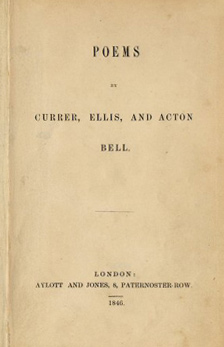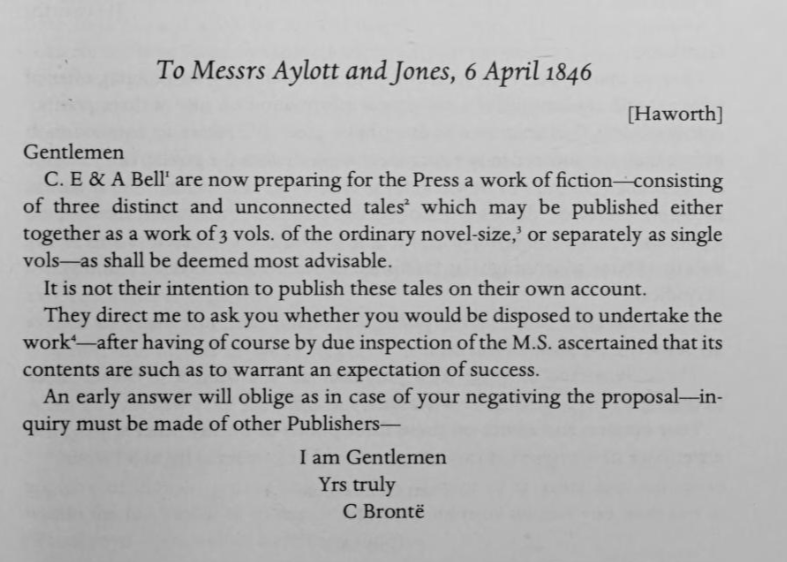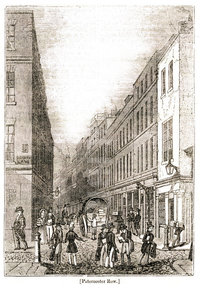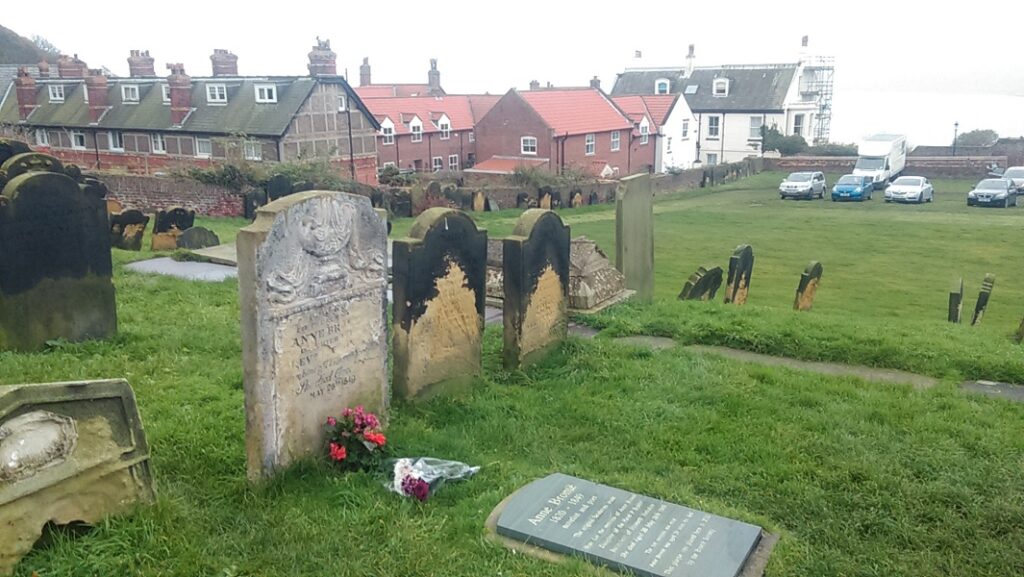1846 was a year that changed literary history forever, and it certainly changed the lives of a certain family of Haworth in ways they could not possibly have imagined. It was the year which saw the publication of the very first book by the Brontë sisters, Poems by Currer, Ellis and Acton Bell. In today’s post we’re going to look at a letter sent on this day in 1846 which shows that their ambitions didn’t end when they became published poets.

The collection of poems had done the rounds of multiple publishers until they alighted upon Aylott & Jones of London who agreed to publish the book by the Bell brothers (as the publisher thought them to be) as long as they covered the expense of printing and publicity. The book did not sell well but it did garner good reviews, and as Charlotte Brontë stated in her biographical notice of Ellis and Acton Bell, they were inspired to turn their hands to a work of fiction:

“Ill-success failed to crush us: the mere effort to succeed had given us a wonderful zest to existence; it must be pursued. We each set to work on a prose tale: Ellis Bell produced ‘Wuthering Heights’, Acton Bell, ‘Agnes Grey’, and Currer Bell also wrote a narrative in one volume. These MSS. [manuscripts] were perseveringly obtruded among various publishers for the space of a year and a half; usually, their fate was an ignominious and abrupt dismissal.”
The first publisher ‘obtruded’ upon in this way was the one they knew best: Aylott & Jones. It was to Aylott & Jones that Charlotte Brontë, posing as an interlocutor for Currer, Ellis and Acton Bell, wrote on the 6th of April 1846:
This letter is a historically important one: it notes the moment in time when Wuthering Heights, Agnes Grey and The Professor were completed and ready to be submitted for publication. The choice of publishers on this occasion, however, was a mistake. Aylott & Jones published poetry along with prose works of a religious nature; secular fiction, such as the Brontës were offering, was not at all their style. Aylott & Jones wrote to Charlotte explaining their stance but they also advised her where she could find the names and addresses of publishers who could potentially accept prose novels. This list was compiled and worked down fastidiously, until eventually Wuthering Heights and Agnes Grey were accepted for publication by Thomas Cautley Newby. The Professor was not accepted, but undaunted as ever Charlotte soon began and completed Jane Eyre – the great novels we love today were now ready to face the world.
The Brontës evidently enjoyed writing, and being published, together, and three volume sets of the kind proposed to Aylott & Jones by Charlotte Brontë were all the rage. The proposed scheme does raise a question however: Wuthering Heights is much longer than the other novels in the planned triumvirate, and it was eventually published in two volumes alongside the one novel of Agnes Grey. Does that mean it was lengthened by Emily after Charlotte’s letter to Aylott & Jones, or that an initial shorter version was sent to the publisher? Like the rumours of a second novel by Emily Brontë, we will never know.

All we do know for sure is that we can be very thankful that the letter was sent to Aylott & Jones, and then on to other publishers. I’m also very grateful to Gary Day, a retired English teacher, Brontë fan and reader of this blog. He very kindly this week sent me a poem he had composed about Anne Brontë’s grave in Scarborough. Entitled “Anne Brontë’s Grave: St Mary’s Church, Scarborough”, it was published last year in a magazine called ‘Lunar Rainbow’ and he has given permission for me to share it with you. I do so below, and a very fine poem it is. I hope you enjoy the poem and I hope also to see you next Sunday for another new Brontë blog post:
At first glance it looks neglected,
Tufts of grass and the brittle stalks
Of some dead flower, yet this is the one
They come to see. Is it a reverence
For the written word that draws them here?
Or because it’s on the tourist trail, along with
The Spa, the Italian Gardens and the Castle,
Still defying its own demise? Odd
Little offerings adorn the base:
A feather, a bracelet, the head
Of a violet and a scattering of pebbles.
The gravestone is flecked with white;
Salt air has corroded the copperplate
Epitaph. Its looping letters have lost
Their curls; now there are spaces where
There were words. Wind and rain
Have blurred the relief of a draped urn
Resting on two novels recording, like
Those of her sisters, the tide of
History rising in provincial lives.
Emily and Charlotte are together
At Haworth but Anne lies alone,
Except for her unfathomable
Visitors and the sea singing to her bones.

